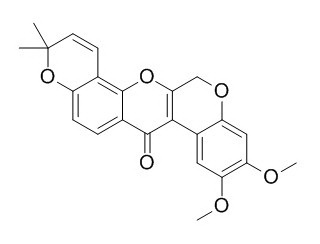Dehydrodeguelin
Standard reference
Inquire / Order:
manager@chemfaces.com
Technical Inquiries:
service@chemfaces.com
Tel:
+86-27-84237783
Fax:
+86-27-84254680
Address:
1 Building, No. 83, CheCheng Rd., Wuhan Economic and Technological Development Zone, Wuhan, Hubei 430056, PRC
Providing storage is as stated on the product vial and the vial is kept tightly sealed, the product can be stored for up to
24 months(2-8C).
Wherever possible, you should prepare and use solutions on the same day. However, if you need to make up stock solutions in advance, we recommend that you store the solution as aliquots in tightly sealed vials at -20C. Generally, these will be useable for up to two weeks. Before use, and prior to opening the vial we recommend that you allow your product to equilibrate to room temperature for at least 1 hour.
Need more advice on solubility, usage and handling? Please email to: service@chemfaces.com
The packaging of the product may have turned upside down during transportation, resulting in the natural compounds adhering to the neck or cap of the vial. take the vial out of its packaging and gently shake to let the compounds fall to the bottom of the vial. for liquid products, centrifuge at 200-500 RPM to gather the liquid at the bottom of the vial. try to avoid loss or contamination during handling.
Cardiovasc Toxicol.2019, 19(4):297-305
Mol Nutr Food Res.2024, 68(20):e2400414.
Cells.2024, 13(14):1229.
Oncol Rep.2016, 35(3):1356-64
J Nat Med.2017, 71(2):380-388
Dicle Tip Dergisi2020, 47(2),423-430.
JEJU National University2022, 24032.
Jeju National University Graduate School2023, 24478
Bull. Pharm. Sci., Assiut University2020, 43(2):149-155.
Phytomedicine.2022, 100:154036.
Related and Featured Products
Parasitol Res. 2010 Nov;107(6):1481-8.
Rotenoids from Lablab purpureus L. and their bioefficacy against human disease vectors.[Pubmed:
20803155]
Various plant parts of Lablab purpureu s L. were collected and analyzed separately for their rotenoid content.
METHODS AND RESULTS:
Among the plant parts, the maximum content was in the roots and minimum in the seeds. The identity of different rotenoids was confirmed by melting point, mixed melting point, UV, and infrared spectral studies and gas-liquid chromatography. Six rotenoids (deguelin, Dehydrodeguelin, rotenol, rotenone, tephrosin, and sumatrol) were isolated, identified, and quantified both in vivo and in vitro.
CONCLUSIONS:
Toxicological studies of extracts showed bioefficacy against causal agents of malaria, dracunculiasis, and amoebiasis.
Nat Prod Commun. 2012 Oct;7(10):1305-7.
Two new flavonoids from the seeds of Derris scandens.[Pubmed:
23156994]
METHODS AND RESULTS:
Two new flavonoids, (2S)-3',4',5'-trimethoxyflavanone (1) and 2'-hydroxy-2,4-dimethoxy-4'-O-[(E)-3,7-dimethyl-2,6-octadienyl]chalcone (2), together with a known pterocarpene, flemichapparin B (3), and a known rotenoid, Dehydrodeguelin (4), were isolated from the seeds of Derris scandens.
CONCLUSIONS:
Their structures were determined by means of extensive 1D and 2D NMR spectral studies.
Phytochemistry. 2008 Jan;69(1):258-63.
Rotenoid derivatives and other constituents of the twigs of Millettia duchesnei.[Pubmed:
17640692]
METHODS AND RESULTS:
Three prenylated rotenoids, elliptol, 12-deoxo-12alpha-methoxyelliptone and 6-methoxy-6a,12a-Dehydrodeguelin were isolated from the twigs of Millettia duchesnei, together with the known compounds, 6a,12a-Dehydrodeguelin, 6-hydroxy-6a,12a-Dehydrodeguelin, 6-oxo-6a,12a-Dehydrodeguelin, elliptone, 12a-hydroxyelliptone and eriodictyol. Their structures were elucidated on the basis of spectral data and comparison with information reported in the literature and with authentic specimens for some known compounds.
CONCLUSIONS:
The full NMR data of 6-oxo-6a,12a-Dehydrodeguelin and 6-hydroxy-6a,12a-Dehydrodeguelin are reported here for the first time.



